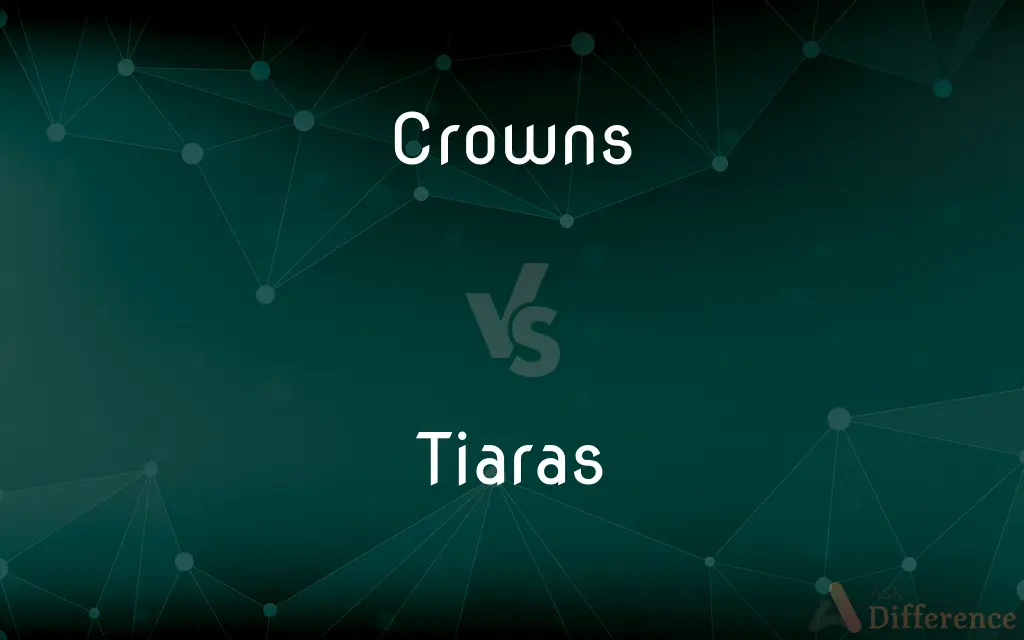Crowns vs. Tiaras — What's the Difference?
Edited by Tayyaba Rehman — By Fiza Rafique — Published on November 16, 2023
Crowns are circular, ornate headpieces symbolizing authority or monarchy, while tiaras are semi-circular, jeweled hair ornaments often associated with nobility or special occasions.

Difference Between Crowns and Tiaras
Table of Contents
ADVERTISEMENT
Key Differences
Crowns and tiaras, both splendid and ornate, are head adornments with distinct purposes and designs. Crowns, recognized universally, represent power, legitimacy, victory, triumph, and glory. Typically made of gold and often embedded with precious stones, crowns are complete circles, encircling the head of monarchs or deities as symbols of authority. Tiaras, on the other hand, are essentially decorative and often chosen for aesthetic appeal over symbolism.
While crowns are often associated with monarchies, tiaras have broader associations. Tiaras are primarily linked to nobility, but they've also become fashionable accessories for brides or individuals attending formal events. Unlike crowns, tiaras are semi-circular and are typically worn by women, adding a touch of elegance and refinement.
The history of crowns and tiaras intertwine with tales of power and luxury. Crowns, throughout history, have been symbols of sovereignty, worn during coronations and state functions. Tiaras, conversely, became especially popular during the 18th and 19th centuries, gracing the heads of European nobility during balls and soirées.
In terms of design, crowns tend to be more robust, often featuring crosses, orbs, or other symbolic motifs. Tiaras are delicate, showcasing intricate designs with diamonds, pearls, and other gemstones.
In essence, while both crowns and tiaras are striking headpieces, their significance, design, and usage set them apart. Crowns are emblematic of power and reign, while tiaras highlight beauty, elegance, and status.
ADVERTISEMENT
Comparison Chart
Shape
Circular.
Semi-circular.
Symbolizes
Authority, monarchy.
Nobility, special occasions.
Worn By
Kings, queens, deities.
Women, especially nobility and brides.
Design Elements
Crosses, orbs, robust motifs.
Diamonds, pearls, intricate and delicate designs.
Historical Significance
Monarchial power and coronations.
European nobility, balls, and soirées.
Compare with Definitions
Crowns
A circular ornate headpiece representing monarchy or authority.
The queen wore her crown during the coronation ceremony.
Tiaras
Popular accessory for brides and nobility.
On her wedding day, she chose a diamond tiara.
Crowns
Symbolic of power, victory, or triumph.
The emperor's crown was a symbol of his vast empire.
Tiaras
Became especially popular in the 18th and 19th centuries.
Vintage tiaras from the 1800s are sought after by collectors.
Crowns
Often made of gold and embedded with precious stones.
The crown, studded with diamonds, gleamed brilliantly.
Tiaras
A semi-circular jeweled hair ornament for women.
The princess wore a tiara to the evening gala.
Crowns
Associated with legitimacy and sovereignty.
The crown signifies the ruler's legitimate claim to the throne.
Tiaras
Highlights beauty, elegance, and status.
Her tiara added a touch of sophistication to her ensemble.
Crowns
An ornamental circlet or head covering, often made of precious metal set with jewels and worn as a symbol of sovereignty.
Tiaras
Intricate designs featuring diamonds, pearls, or other gemstones.
The tiara's sapphire centerpiece caught everyone's attention.
Crowns
The power, position, or empire of a monarch or of a state governed by constitutional monarchy.
Tiaras
An ornamental, often jeweled, crownlike semicircle worn on the head, especially by women on formal occasions.
Crowns
The monarch as head of state.
Tiaras
The triple crown historically worn by the pope, especially at his coronation ceremony, and still used heraldically as a symbol of the papacy.
Crowns
A distinction or reward for achievement, especially a title signifying championship in a sport.
Tiaras
Plural of tiara
Crowns
Something resembling a diadem in shape.
Crowns
A coin stamped with a crown or crowned head on one side.
Crowns
Abbr. cr. A silver coin formerly used in Great Britain and worth five shillings.
Crowns
Any one of several coins, such as the koruna, the krona, or the krone, having a name that means “crown.”
Crowns
The top or highest part of the head.
Crowns
The head itself.
Crowns
The top or upper part of a hat.
Crowns
The highest point or summit.
Crowns
The highest, primary, or most valuable part, attribute, or state
Considered the rare Turkish stamp the crown of their collection.
Crowns
The part of a tooth that is covered by enamel and projects beyond the gum line.
Crowns
An artificial substitute for the natural crown of a tooth.
Crowns
(Nautical) The lowest part of an anchor, where the arms are joined to the shank.
Crowns
(Architecture) The highest portion of an arch, including the keystone.
Crowns
The upper, spreading part of a tree or shrub.
Crowns
The part of a plant, usually at ground level, where the stem and roots merge.
Crowns
The persistent, mostly underground base of a perennial herb.
Crowns
See corona.
Crowns
The crest of an animal, especially of a bird.
Crowns
The portion of a cut gem above the girdle.
Crowns
To put a crown or garland on the head of.
Crowns
To invest with regal power; enthrone.
Crowns
To confer honor, dignity, or reward upon.
Crowns
To surmount or be the highest part of.
Crowns
To form the crown, top, or chief ornament of.
Crowns
To bring to completion or successful conclusion; consummate
Crowned the event with a lavish reception.
Crowns
(Dentistry) To put a crown on (a tooth).
Crowns
(Games) To make (a piece in checkers that has reached the last row) into a king by placing another piece upon it.
Crowns
(Informal) To hit on the head.
Crowns
To reach a stage in labor when a large segment of the fetal scalp is visible at the vaginal orifice. Used of a fetus.
Crowns
Plural of crown
Crowns
Infl of crown
Crowns
Worn during significant state or religious ceremonies.
During the state visit, the king's crown was prominently displayed.
Common Curiosities
Are all crowns made of gold?
While many crowns are gold, they can be made of various metals and adorned with precious stones.
Are tiaras reserved only for royalty?
No, tiaras are worn by nobility and commoners alike, especially for special occasions or weddings.
Can men wear tiaras?
Traditionally, tiaras are for women, but fashion is subjective, and there's no strict rule against men wearing them.
Are tiaras and crowns the same thing?
No, crowns are circular and symbolize authority, while tiaras are semi-circular and more decorative.
Can tiaras be passed down as heirlooms?
Yes, many families pass down tiaras as treasured heirlooms.
Are tiaras only made of diamonds?
No, tiaras can be adorned with various gemstones like pearls, sapphires, and more.
What is the main purpose of crowns?
Crowns symbolize authority, monarchy, and legitimacy.
Do crowns have specific designs for different monarchs?
Yes, crowns are often specially designed, reflecting the monarchy's history or the individual monarch's preferences.
Why are crowns featured on coins or national emblems?
Crowns on such items symbolize the reigning monarchy or the nation's sovereignty.
How should one wear a tiara?
Tiaras are typically worn towards the front of the head, but placement can vary based on hairstyle and preference.
Are crowns worn daily by monarchs?
No, crowns are reserved for significant state or religious ceremonies.
Who typically wears a crown?
Monarchs, such as kings and queens, typically wear crowns during significant ceremonies.
What occasions deem wearing a tiara appropriate?
Tiaras can be worn at formal events, weddings, balls, and by members of the nobility or royalty.
Is it common for brides to wear tiaras today?
Yes, many brides choose to wear tiaras as part of their bridal ensemble.
Can anyone buy a crown?
While crowns symbolize authority, replicas or decorative crowns can be purchased by anyone.
Share Your Discovery

Previous Comparison
Zinc Gluconate vs. Zinc Glycinate
Next Comparison
Black Beans vs. Pinto BeansAuthor Spotlight
Written by
Fiza RafiqueFiza Rafique is a skilled content writer at AskDifference.com, where she meticulously refines and enhances written pieces. Drawing from her vast editorial expertise, Fiza ensures clarity, accuracy, and precision in every article. Passionate about language, she continually seeks to elevate the quality of content for readers worldwide.
Edited by
Tayyaba RehmanTayyaba Rehman is a distinguished writer, currently serving as a primary contributor to askdifference.com. As a researcher in semantics and etymology, Tayyaba's passion for the complexity of languages and their distinctions has found a perfect home on the platform. Tayyaba delves into the intricacies of language, distinguishing between commonly confused words and phrases, thereby providing clarity for readers worldwide.
















































